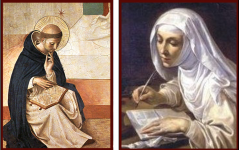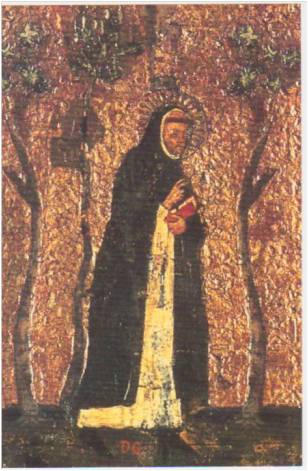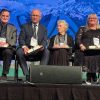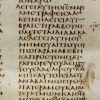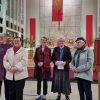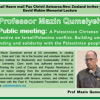 DOMINICAN LAITY
DOMINICAN LAITY
Newsletter #12
August 2010
Dear members of the New Zealand Dominican family
This is a significant week for all Dominicans. Yesterday, 2 August, was the feast of Blessed Jane of Aza, mother of Saint Dominic and Blessed Mannes, and Saturday is St Dominic’s day. We thank God for the blessings these holy people have given the world.
A message from Fr David Kammler
S.Domenico “Ambulate in veritate et caritate” (Part.tavola – sec.XIII)
Napoli – Galleria Nazionale di Capodimonte
« How beautiful on the mountains, are the feet of the messenger announcing
peace, of the messenger of good news, who proclaims salvation! » (Isaiah 52,7)
Let us follow, as Dominican Family of 2010, the admonition of our Father St. Dominic: « Walk along in Truth and Charity »!*
Que sigamos, como Familia Dominicana en 2010, la exhortación de nuestro
Padre Santo Domingo: « Caminen en la Verdad y la Caridad »!*
Que nous suivons, comme famille dominicaine de 2010, l’exhortation de
notre Père saint Dominique: « Marchez dans la Vérité et la Charité »!
*
Cerchiamo di seguire, come Famiglia Domenicana nel 2010, il monito del
nostro Padre nostro, San Domenico: « Camminate nella Verità e nella Carità »!
*
Folgen wir, als Dominikanische Familie des Jahres 2010, der Ermahnung
unseres Vaters St. Dominikus: « Geht einher in Wahrheit und Liebe »!
A blessed feast of St. Dominic to you and all Dominican Family members of your country!
Your brother serving as Promoter General of Dominican Laityfr. David M. Kammler OP
IMPORTANT NEWS
OUR PLACE IN THE FUTURE CHURCH
This one-day workshop is being held in 7 different places, and we do hope that you are able to attend this Dominican project.
It is presented by Rev NEIL DARRAGH, a theologian, author, formerly head of the Catholic Institute of Theology. Fr Neil is an excellent speaker with some challenging things to say about the future of our Church:
What would be our mission in the wider world?
What changes will we make to get there?
| The Auckland workshop took place in June, and we trust that those able to attend that occasion found it interesting and challenging. Other workshops are to be held as follows: | |
| CHRISTCHURCHKnox Centre, Bealey AvenueSaturday 14 August 2010, 9.30am to 3.30pm | DUNEDINSt Patrick’s Parish Centre, Macandrew RoadSunday 15 August 2010, 9.30am to 3.30pm |
| INVERCARGILL St Patrick’s Parish Room, South InvercargillSaturday 21 August 2010, 9.30am to 3.30pm | OAMARU Catholic Parish Centre, Reed StreetSunday 22 August 2010, 10.45am to 4.30pm |
| PALMERSTON NORTH Diocesan Centre, 33 Amesbury StreetSaturday 4 September 2010, 9.30am to 3.30pm | WELLINGTONConnolly Hall, Guilford TerraceSunday 5 September 2010, 11am to 4.30pm |
Bring your own lunch. Admission $10 or koha.
AN INVITATION TO THE GENERAL CHAPTER OF THE SISTERS
In January the sisters hold their General Chapter in Dunedin. The first two days of the Chapter will be devoted to the theme:
Dominicans – a Family of Contemplative Preachers
In attendance will be two superb Dominican presenters from USA – Ann Willits OP and Matt Walsh OP.
The Chapter begins with dinner on Friday 7 January 2011, and the theme will be explored for two days 8-9 January.
Accommodation will be available at St Margaret’s College in Dunedin.
If interested, please contact the newsletter co-ordinators Mike and Jenny and we can send you an application form. Places may be limited, and bookings are requested by 1 November.
Lay Gathering: developments
Following the inaugural gathering of lay Dominicans in Wellington in May, a start is being made on some aspects of organisation.
John Collins is currently setting up a meeting of members of the steering group.
For the group charged with developing a formation process, we are delighted to be joined by Fr Chris Loughlan, representing the friars, and Sr Judith McGinley, representing the sisters.
Jenny Wilson, who has acted as treasurer for the purpose of the gathering, offers the following financial report:
Financial Statement for Dominican Lay Meeting May 2010
[Please refer to the Newsletter Co-Ordinators for a copy of the statement]This statement has been reviewed by Mr William Orange, Masterton.
Signed: W Orange ACAC (now retired)
Checking up on the workers: the Vatican and the sisters in America
Many people are aware of the regular column written by Sr Joan Chittister, a Benedictine sister who has no hesitation in calling a spade a spade when it comes to Church dealings. You may also know that the Vatican has decided to make a detailed examination (officially called an “ Apostolic visitation”) of all women’s religious congregations in America, to check whether they meet Church requirements. This examination is led by a “visitator”, Cardinal Franc Rode. The event has caused much debate within the Church in USA.
Here is Sr Joan’s reaction to what is happening.
Apostolic Visitation: Why Bother? Why be Bothered?
By Joan Chittister
The question is, why bother? That’s the question rumbling under an otherwise polite attempt to participate in a process based on non-participation.
While the world goes on to bigger things–like oil spills that threaten an entire body of water in addition to all the beaches and marshes and wildlife and families they harbor; while women religious themselves go steadfastly on serving the poor, working for justice, and attempting to make peace among peoples of every faith and culture; and while the church universal continues to deal with the effects of sex scandals everywhere, church embezzlements everywhere and the closing of churches and missions worldwide, the investigation, inquisition, and/or evaluation of women religious in the United States–whatever the euphemisms for it–continues on its weary way. Oblivious, it appears, to all those other things.
No one seems to be sure why the investigation is really being done, except that to declare an Apostolic Visitation signals that someone somewhere has already decided that something is wrong. More than that, no one seems to know where it will really go or how it will end: a report in a drawer; maybe; one more document on religious life after over 1500 years of history, perhaps; a set of foreign “do’s and don’ts” for adult women who have freely given and freely spend their lives for the sake of what one congregation, the Sisters of St Joseph, so poignantly calls “the dear neighbor” and others, Benedictines, for instance, call “the search for God.”
But however uncertain the purpose and end of such an investigation, two other things are patently clear: First, it is costing over a million dollars to send teams of strangers into convents and monasteries across the land for five day analyses of the local religious culture. And second, however benignly the whole process may turn out to be, one sentence shows up in every official explanation of the process – one sentence that continues to raise questions about the standard operational procedures of the church itself. It reads, from a number of news reports on the subject, “The process will conclude in 2011 with a final report to Cardinal Rode. The report will not be made public or shared with the religious communities.”
What? The report won’t be shared with the communities being investigated? The patient will not be told the diagnosis? The accused will not be told the crime? The paralytic will not be asked whether or not crutches can really solve her particular situation?
Oh, come now.
No wonder there’s so much gall about such a study.
It isn’t that this is not a period of institutional evaluations. It isn’t that nuns haven’t been part of them over and over again for years–in schools, in hospitals, in professional organizations, in their own congregations. On the contrary. These things are standard operating procedure these days. But not like this.
In professional evaluations of member groups, the process is marked by four distinct dimensions: 1. A preliminary self-study, 2. An evaluation by peers, 3. An exit report and 4. A written report that responds to each area of the group’s own self evaluation materials.
The preliminary self-study covers every area the membership organization defines as essential or important to its being an accredited institution in the evaluating association. It cites what the membership of the group being evaluated defines as its strengths, its present weaknesses and its plans for the future. The visitation process, by making the evaluation a joint endeavor between a local group and its external evaluators, honors the insights and commitment of the group itself. And all of this is done against a backdrop of common goals both shaped and shared by the association and this particular unit of it.
But, in this case, there was no preliminary or jointly planned self-study.
An evaluating team made up of peers from the same system does not bring apples to judge oranges. Engineers do not grade English departments; high school teachers do not pronounce on grade school curriculums; pharmacists do not write recommendations for health food programs. These evaluators are people who are themselves both expert in the field and grappling with the same problems somewhere else. The message is a clear one: We’re all in this together. Let’s see what your experience and mine have to share with one another.
But new understandings of how best to live a vowed life in a modern society have grown up since Vatican II–and been approved by Rome. It is unclear how many of the visitators themselves have lived these current forms.
An on-site exit report and dialogue about the visitators’ immediate perceptions of the professional health of the group in question is common. It brings a kind of closure to the process.
But to have no idea at all of the immediate concerns or commendations of outside observers at the end of the process, leaves in its wake more the taste of an invisible threat than a sense of mutual achievement.
Finally, in most professional evaluations, the group has the opportunity to make a written response to the team’s official report in order to explain why some of the recommendations–good as they may be for others of its kind–cannot or does not apply to this group at this time.
From where I stand, a secret report is no report at all. When evaluators are allowed to make “reports” that are never seen by the people or programs about which they are “reporting,” anything can be said by anybody–without cause and without proof. Without challenge and without joint resolution. It brings with it no accountability at all from the evaluators themselves, either for its facticity or its applicability to the circumstances of any particular group, let alone all of them.
In that case, there’s no reason to do an investigation at all. The so-called report can be written before the visitators even visit. In fact, why bother?
But there is another question, equally important, that demands an answer, too. That question is “Why would anyone be bothered about such an ill-defined process?” And the answer to that question is a simple one: an Apostolic Visitation carries in its wake the canonical possibility that a community’s superior can be removed without explanation, or the community itself can be suppressed, or outside administrators can be appointed and installed without community approval. It can, in other words, change a community’s entire life on the basis of a report they have never seen.
Clearly, religious–in fact, any group of people anywhere– have a right to be concerned about the effects on them of a process that allows them to be convicted of something of which they were never told they were accused.
Remember: we would love to hear from readers of this newsletter
We would especially like to have reports of any celebrations of the feast of Saint Dominic!
Mike Kelly and Jenny Wilson
Co-ordinators
Ph 06 370 2084 Email: kelly-wilson@ihug.co.nz
